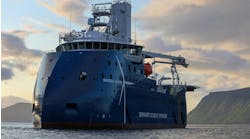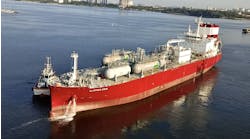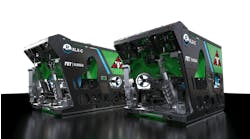Shifting from horizontal to vertical position is the most time-consuming function for drillpipe and casing pipe handling systems. National Oilwell engineers claim that the firm's newly developed horizontal-to-vertical (HTV®) pipe handling technology, well conditions allowing, can pare off as much as 50% of the time it takes to run that casing or drillpipe.
Santa Fe International, which initiated the requirement for the HTV concept, worked closely with National Oilwell on its development and will capitalize on the new system in the construction of two newbuild jackups.
The HTV takes a double stands of casing or a triple stands of drill pipe (roughly 90 ft long) from the horizontal orientation on the cantilevered deck to a vertical position at the derrick vee-door entrance. Once the pipe or casing is vertical, a drill floor star racker takes the pipe and either racks it for storage or moves it to well center to be set. The trolley carries two stands at a time, and its casing running cycle time (pickup, set two stands of pipe, return to pickup) takes only six minutes, or 10 cycles per hour.
Designers have optimized the HTV system to eliminate "wait" in the casing running process, and the precise time sequencing has minimized stall time to make the new system efficient.
Elements of the system
The HTV system has three principle components:
- Crane capacity sufficient to move single joints of tubulars into the make-up unit and made-up stands into the storage area.
- Make-up subsystem, which has pipe supports, to accommodate and align two or three single joints of tubulars and two wrenches to make up and break out connections. The HTV system is also fully capable of handling single joints of drilling tubulars and casing.
- Transfer trolley to move stands from their horizontal position on the catwalk to a vertical position on the drill floor. A simple hoist raises the trolley from horizontal to vertical, and gravity returns the trolley to the pipe deck.
Made-up stands of tubulars are retained on the trolley with mechanical locks that are secured at the pipe deck and opened in the derrick. Because the locks are actuated at the horizontal and vertical docking stations and are not powered on the trolley, no hydraulic, electrical, or air umbilical is required.
Design advantages
Typically, the horizontal-to-vertical machines used to move drill pipe or casing have handled only singles, a limitation that the new design has eliminated. Santa Fe's newbuild jackup design features an extra-long pipe deck that allows the rig to handle the 90-ft stands of horizontal pipe. The company's newbuilds will also feature a special derrick with a broad opening in the derrick base that allows the trolley to move a 90-ft stand of pipe/casing from the horizontal to vertical position.
The new horizontal arrangement of casing/drill pipe provides space for a large number of stands to be made up in advance of when they are needed. In order to take advantage of the storage space, designers took a new look at how to make up stands.
The result is the application of standard equipment in a different way. A pipe coupling machine (Iron Roughneck) operates with pipe spinners and casing tongs to make up stands in the horizontal orientation, and the rack holds the made-up stands ready for use.
The setback area on the new jackups is of a conventional size and stores made-up stands of pipe. For rig moves, tubular stands are stored on the horizontal pipe deck, rather than vertically in a setback area.
Holding the stands horizontally lowers the rig's center of gravity because most of the weight is carried on the deck, reducing the loads and forces at work on a floating rig. In addition, the system adds flexibility. Tubular stands can be assembled in an area away from the drilling operation.
Critical path
A significant benefit of the HTV system is that it shifts part of the normal well tubular handling activity from the drill floor to the cantilever decks, which creates far reaching jump!
benefits, including removal of major activities from the critical path.
Some standard operations no longer impact critical path operations. Make-up and breakdown activities for the picking up and laying down of the drill floor is cut almost in half. Other efficiencies include:
- Decreasing string running times for tubulars because the HTV handles stands instead of single lengths.
- Concurrent drill floor tubular handling activities
- Minimized exposure of personnel to tubular running activity
- Cantileaver tubular racking area sized for well tubular strings stored in stands.
Minimizing time delays
The pipe-handling concept reduces the number of sequential elements in the well construction critical path, and thus reduces the number of potential delays in completing a well. Drill string stand assembley, disassembly, and transfer (from the deck to the drill floor) are outside the well construction critical path. The system is flexible enough to handle drillstring stands in parallel with other well construction activities, which translates into time savings.
Running tubulars into the well is on the critical path, but the new system reduces the time required for this activity by allowing the well tubular stands to move from the deck to the well via the drillfloor star racker, which is able to hold several stands of pipe in reserve so that there are always stands of pipe ready to be set. Drilling activities can progress more rapidly because there is no delay in making up and positioning stands of pipe.
Retrofitting option
The HTV system is not restricted to installation on newbuilds. With some modification to the original design, the system can also be installed on existing jackups or semisubmersibles. However, the space requirement for accommodating 90-ft stand of horizontal pipe will rule out many rigs as potential candidates for the original HTV system unless the deck is elongated to handle the horizontal storage of made-up stands.
In a case where a rig cannot be modified to handle the horizontal make-up equipment, an alternative solution would be a modified version of the system that handles only single stands of casing and drill pipe.
The modified trolley operation requires a different derrick structure and accommodates a different load capacity, which resulet in a lowe stand weight and a smaller, lighter trolley.





